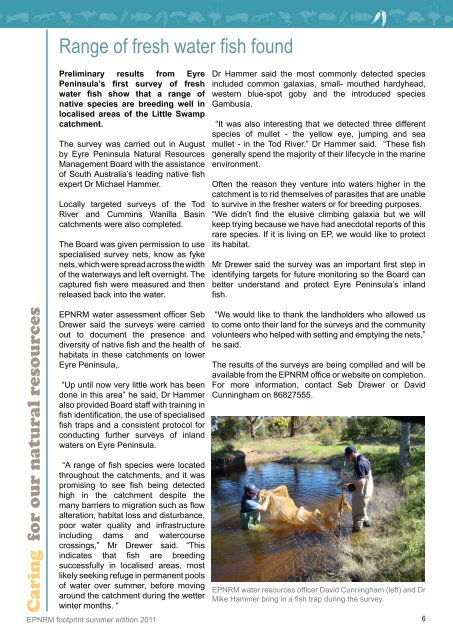The Footprint 2011 Summer Edition - Eyre Peninsula Natural ...
The Footprint 2011 Summer Edition - Eyre Peninsula Natural ...
The Footprint 2011 Summer Edition - Eyre Peninsula Natural ...
You also want an ePaper? Increase the reach of your titles
YUMPU automatically turns print PDFs into web optimized ePapers that Google loves.
Range of fresh water fish found<br />
Caring for our natural resources<br />
Preliminary results from <strong>Eyre</strong><br />
<strong>Peninsula</strong>’s first survey of fresh<br />
water fish show that a range of<br />
native species are breeding well in<br />
localised areas of the Little Swamp<br />
catchment.<br />
<strong>The</strong> survey was carried out in August<br />
by <strong>Eyre</strong> <strong>Peninsula</strong> <strong>Natural</strong> Resources<br />
Management Board with the assistance<br />
of South Australia’s leading native fish<br />
expert Dr Michael Hammer.<br />
Locally targeted surveys of the Tod<br />
River and Cummins Wanilla Basin<br />
catchments were also completed.<br />
<strong>The</strong> Board was given permission to use<br />
specialised survey nets, know as fyke<br />
nets, which were spread across the width<br />
of the waterways and left overnight. <strong>The</strong><br />
captured fish were measured and then<br />
released back into the water.<br />
EPNRM water assessment officer Seb<br />
Drewer said the surveys were carried<br />
out to document the presence and<br />
diversity of native fish and the health of<br />
habitats in these catchments on lower<br />
<strong>Eyre</strong> <strong>Peninsula</strong>,.<br />
“Up until now very little work has been<br />
done in this area” he said, Dr Hammer<br />
also provided Board staff with training in<br />
fish identification, the use of specialised<br />
fish traps and a consistent protocol for<br />
conducting further surveys of inland<br />
waters on <strong>Eyre</strong> <strong>Peninsula</strong>.<br />
“A range of fish species were located<br />
throughout the catchments, and it was<br />
promising to see fish being detected<br />
high in the catchment despite the<br />
many barriers to migration such as flow<br />
alteration, habitat loss and disturbance,<br />
poor water quality and infrastructure<br />
including dams and watercourse<br />
crossings,” Mr Drewer said. “This<br />
indicates that fish are breeding<br />
successfully in localised areas, most<br />
likely seeking refuge in permanent pools<br />
of water over summer, before moving<br />
around the catchment during the wetter<br />
winter months. “<br />
EPNRM footprint summer edition <strong>2011</strong><br />
Dr Hammer said the most commonly detected species<br />
included common galaxias, small- mouthed hardyhead,<br />
western blue-spot goby and the introduced species<br />
Gambusia.<br />
“It was also interesting that we detected three different<br />
species of mullet - the yellow eye, jumping and sea<br />
mullet - in the Tod River.” Dr Hammer said. “<strong>The</strong>se fish<br />
generally spend the majority of their lifecycle in the marine<br />
environment.<br />
Often the reason they venture into waters higher in the<br />
catchment is to rid themselves of parasites that are unable<br />
to survive in the fresher waters or for breeding purposes.<br />
“We didn’t find the elusive climbing galaxia but we will<br />
keep trying because we have had anecdotal reports of this<br />
rare species. If it is living on EP, we would like to protect<br />
its habitat.<br />
Mr Drewer said the survey was an important first step in<br />
identifying targets for future monitoring so the Board can<br />
better understand and protect <strong>Eyre</strong> <strong>Peninsula</strong>’s inland<br />
fish.<br />
“We would like to thank the landholders who allowed us<br />
to come onto their land for the surveys and the community<br />
volunteers who helped with setting and emptying the nets,”<br />
he said.<br />
<strong>The</strong> results of the surveys are being compiled and will be<br />
available from the EPNRM office or website on completion.<br />
For more information, contact Seb Drewer or David<br />
Cunningham on 86827555.<br />
EPNRM water resources officer David Cunningham (left) and Dr<br />
Mike Hammer bring in a fish trap during the survey.<br />
6

















